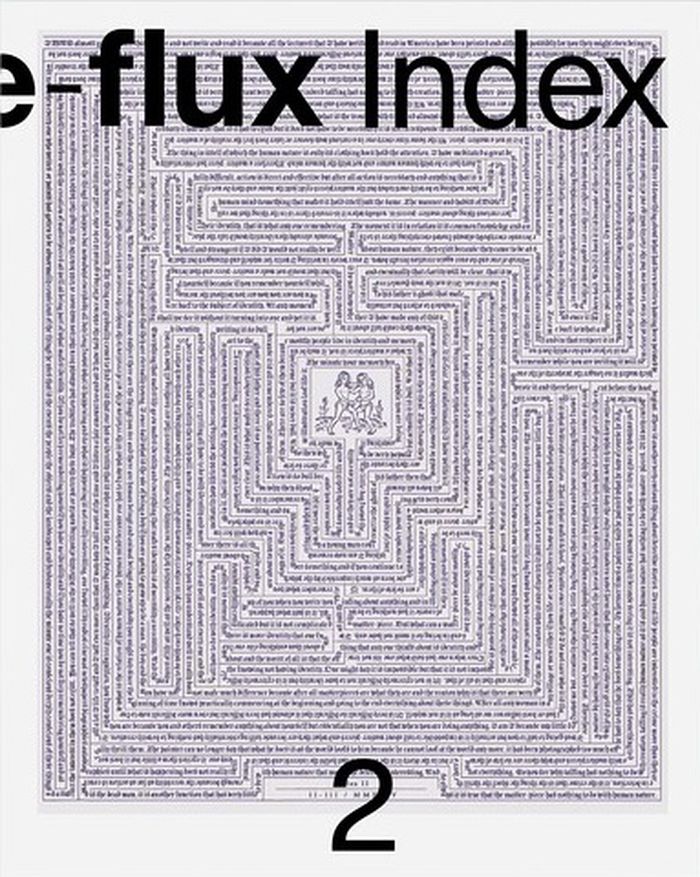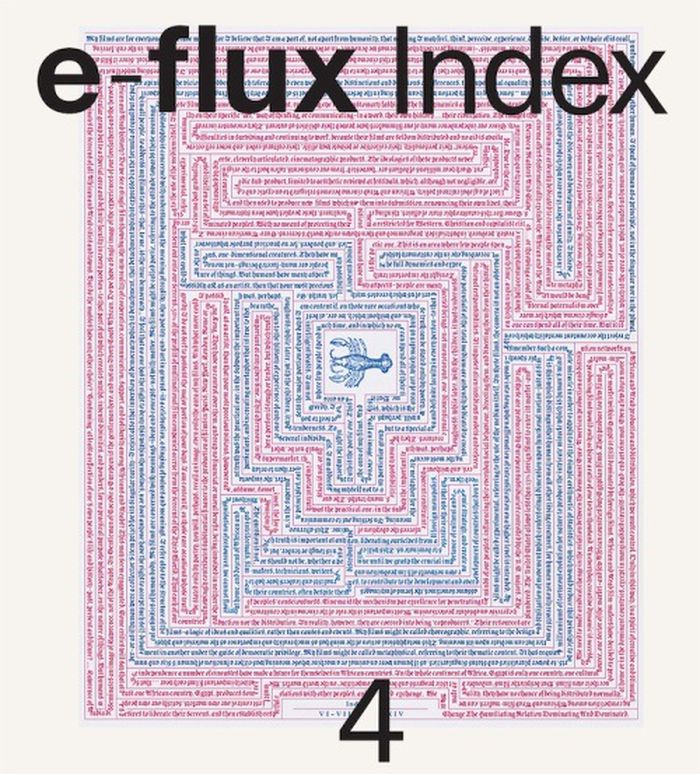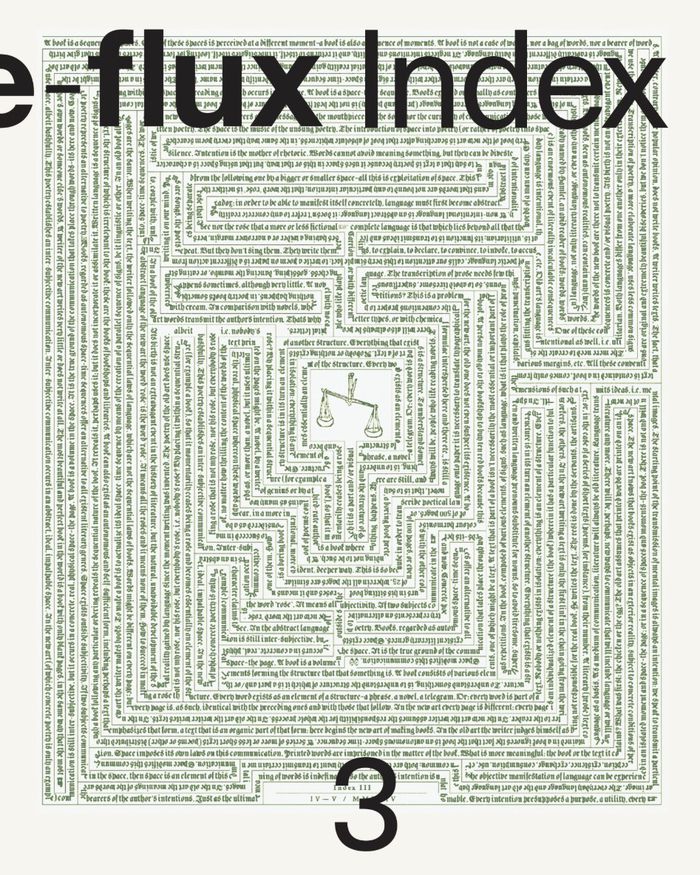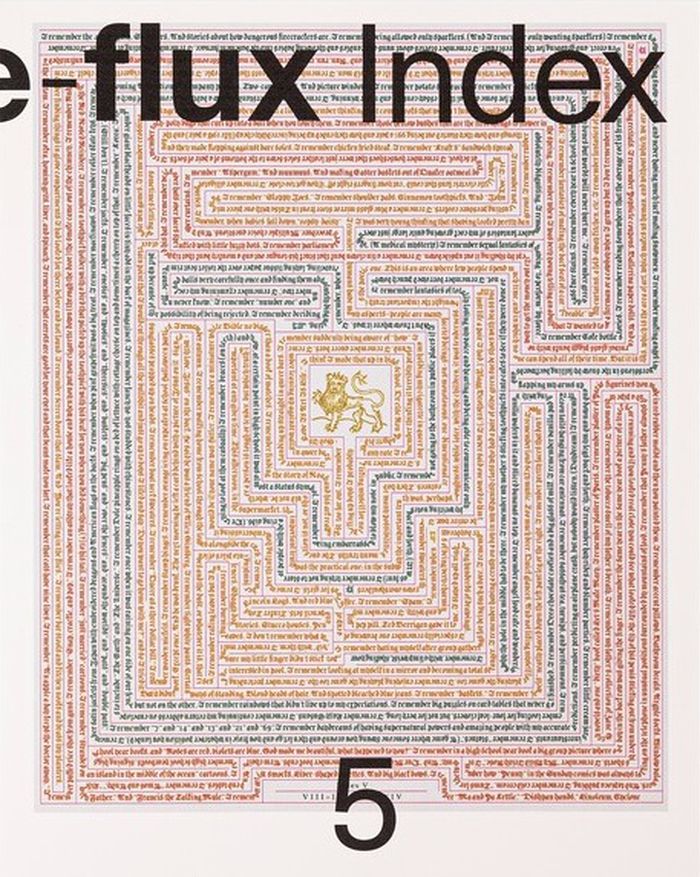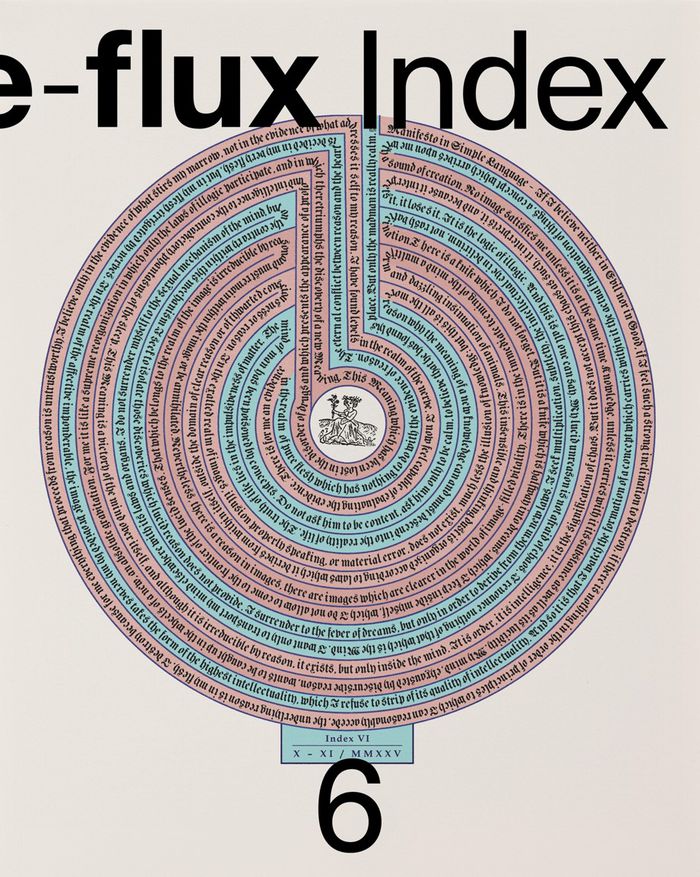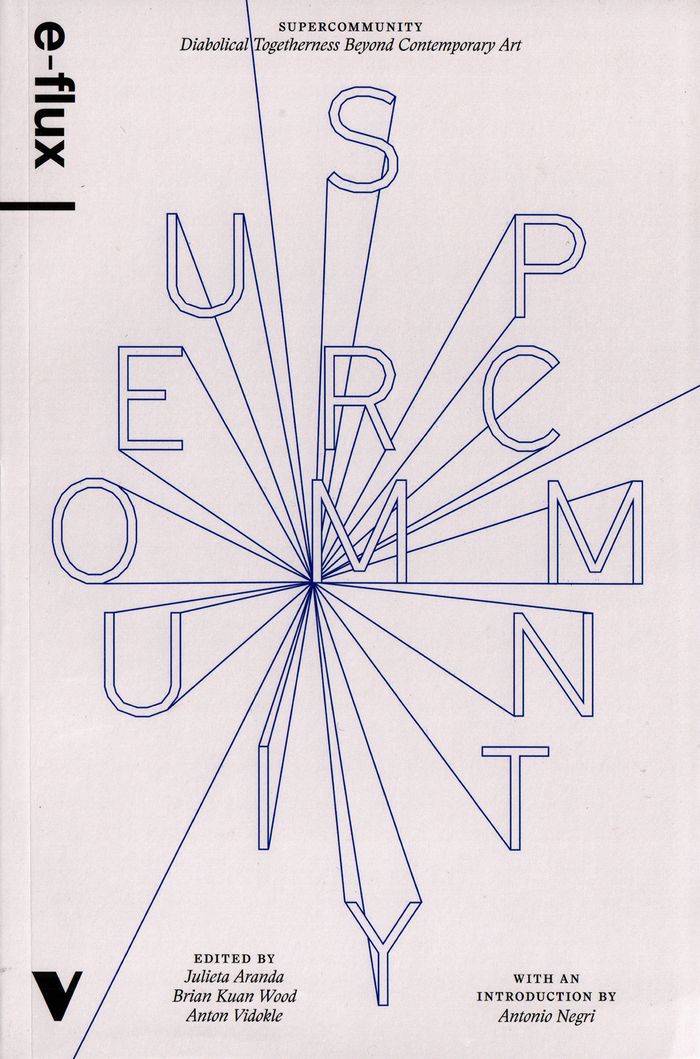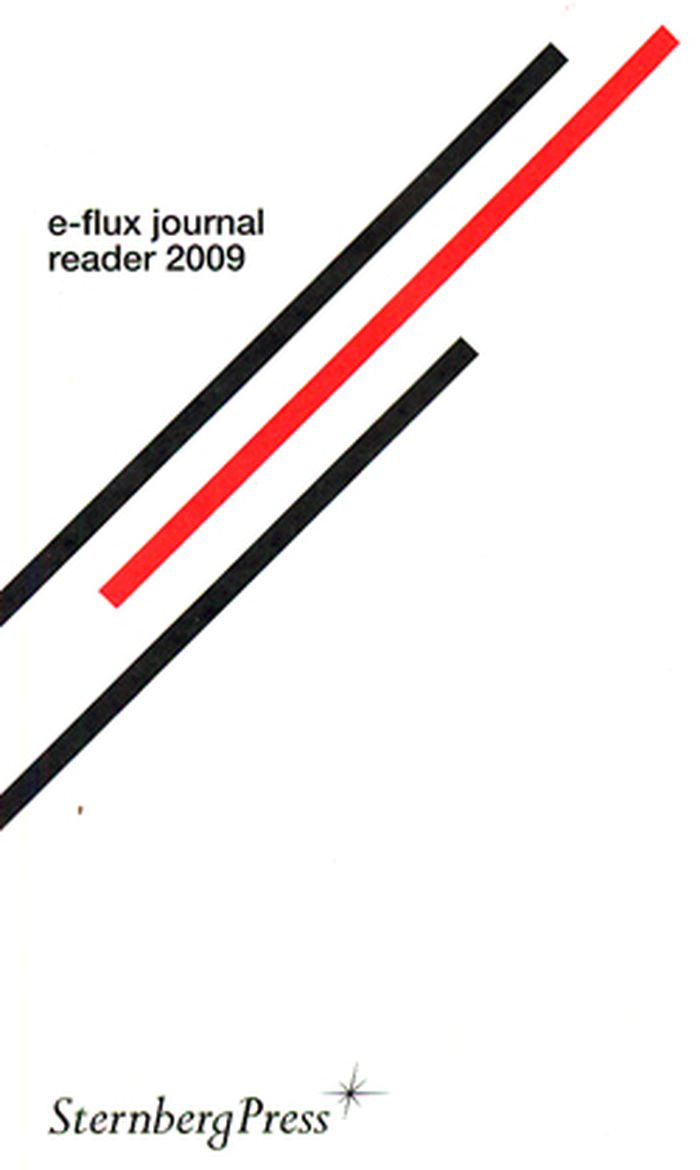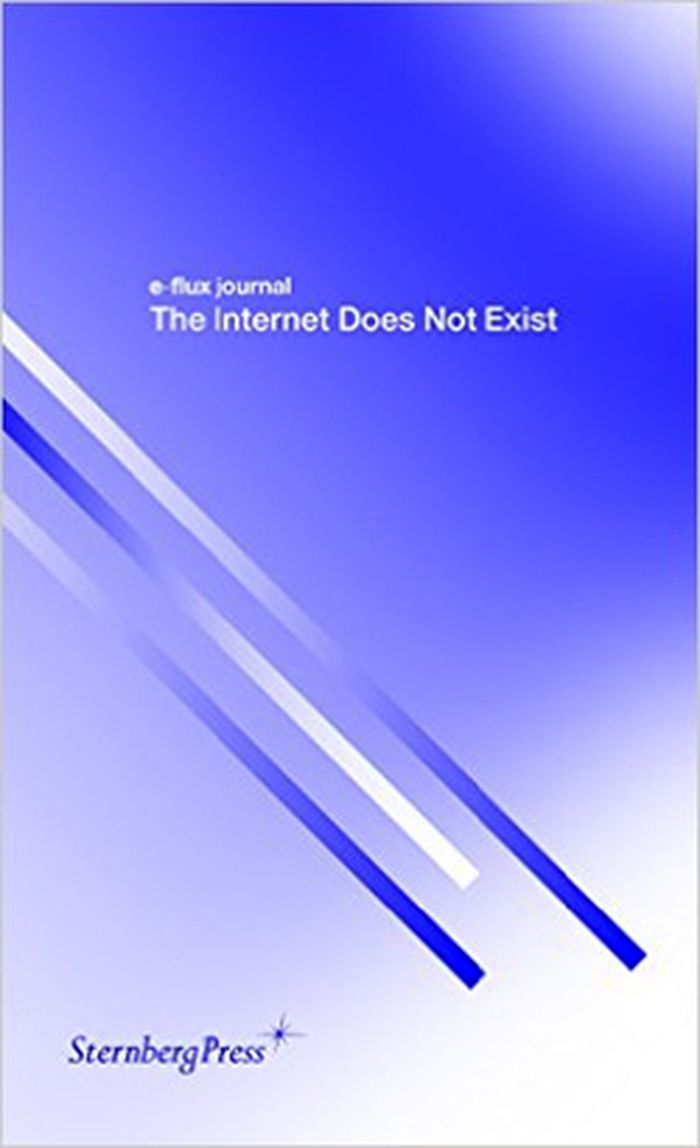e-flux Index #2
$65.00
(available in store)
Summary:
"It’s always too late, whenever you take a photograph." This laconic remark, which I heard during a recent artist’s talk in Berlin, bubbled up from a discussion upon the often-tragic indexicality or nonindexicality of contemporary photographic practice. JPEGs taken for wonders. Smoke plumes without embers. Footprints crossing the beaches of abandoned resorts. Hands that(...)
e-flux Index #2
Actions:
Price:
$65.00
(available in store)
Summary:
"It’s always too late, whenever you take a photograph." This laconic remark, which I heard during a recent artist’s talk in Berlin, bubbled up from a discussion upon the often-tragic indexicality or nonindexicality of contemporary photographic practice. JPEGs taken for wonders. Smoke plumes without embers. Footprints crossing the beaches of abandoned resorts. Hands that point at nothing in particular, and the gullible eyes that follow the lead of pointing index fingers. There is indeed something awkward to the snapshot’s belatedness. Its untimeliness. The ways in which, the second the shutter clicks—or that our thumb melds with the appropriate region of our phone’s liquid plasma displays and the resultant file is uploaded to a distant server—the instant we sought to "capture" has passed by and something else enters the frame. Someone blinks, the rubble dust envelopes the scene, the light changes, the hoodie we saw underground bearing the phrase "THEIR DESTINIES WOULD INTERTWINE" disappears behind an arriving subway’s blur, the wind cajoles a neighboring branch we hadn’t before noticed into the family portrait. Photography then remains, contrary to the terms in which it is sold to us by Silicon Valley manufacturers who stress its total immediacy as an instrument for perceiving the world, a stubbornly untimely pursuit. Can we not also say, "It’s always too late, whenever you start to index"?
Magazines
E-flux index #4
$65.00
(available in store)
Summary:
68 contributions from an international selection of critics, artists, poets, architects, filmmakers, and theorists: the fourth issue of e-flux Index features everything published on e-flux.com from June–July 2024. e-flux Index is a bimonthly print compendium of today’s most vital writing on art, culture, and theory from across e-flux’s publishing platforms. It combines(...)
E-flux index #4
Actions:
Price:
$65.00
(available in store)
Summary:
68 contributions from an international selection of critics, artists, poets, architects, filmmakers, and theorists: the fourth issue of e-flux Index features everything published on e-flux.com from June–July 2024. e-flux Index is a bimonthly print compendium of today’s most vital writing on art, culture, and theory from across e-flux’s publishing platforms. It combines long-form essays from e-flux Journal and Architecture, reviews of exhibitions, books, and films from e-flux Criticism, articles and interviews by students and teachers from e-flux Education, and opinion pieces from e-flux Notes, organizing them thematically to “index the arts” and archive the present.
Magazines
e-flux index #3
$65.00
(available in store)
Summary:
Today we are accustomed to the apophatic gesture of free-speech fundamentalists and far-right demagogues, who use the flimsy legal cover of “just asking questions” to broadcast ever more widely the most violent and reactionary forms of hate speech. In resisting this enclosure of thought, art and theory continue to be instructive, if not essential activities. The late(...)
e-flux index #3
Actions:
Price:
$65.00
(available in store)
Summary:
Today we are accustomed to the apophatic gesture of free-speech fundamentalists and far-right demagogues, who use the flimsy legal cover of “just asking questions” to broadcast ever more widely the most violent and reactionary forms of hate speech. In resisting this enclosure of thought, art and theory continue to be instructive, if not essential activities. The late Lawrence Weiner memorably declared that “the purpose of art is to ask questions… it doesn’t answer anybody’s question but gives them the means to answer a particular question at a particular moment.” All the better when those questions can provoke a certain illuminating friction with the contradictions of one’s environment and disrupt the automaticity of one’s learned responses, remaining themselves ambiguous or unanswered—because unanswerable. This third issue of e-flux Index, bringing together all the content commissioned and published by e-flux between April and May 2024, contains many such unexpected and unanswered (or unanswerable) questions across its 76 contributions, each of which cut across and reach beyond existing disciplines and borders: “Who is willing to care?”; “Who is the addressee at the end of the regulated pipelines of the English language?”; “Yes, but is it edible?”; “Why does everyone hate college students?”; “Is some form of suffering the condition for the emergence of an organic type of intelligence?”; “What does it mean to make a film today, in 2024, when most of our image consumption has been transferred to other (smaller) screens and other media?; “How to represent history?”; “Whose lives are worth remembering—or even, living?”; “How is it possible to speak the language of imperial renaissance and decolonization in the same breath?”; “Today is which day of the revolution?”—“Are these all just notes for a poem?”
Magazines
E-flux index #5
$65.00
(available in store)
Summary:
This fifth issue of the e-flux Index, comprises nine new categories for sorting it all out. These are titled: Is That All There Is?; What a Body Can Do; The Physicists’ Laugh; Dens, clubs, hives, and cells; The Tourist; Flickers; Promethean Shame; Proxies; and Inextinguishable Fires. In the exploratory spirit of Bas Jan Ader’s Primary Time (1974) or Susan Hiller’s remarks(...)
E-flux index #5
Actions:
Price:
$65.00
(available in store)
Summary:
This fifth issue of the e-flux Index, comprises nine new categories for sorting it all out. These are titled: Is That All There Is?; What a Body Can Do; The Physicists’ Laugh; Dens, clubs, hives, and cells; The Tourist; Flickers; Promethean Shame; Proxies; and Inextinguishable Fires. In the exploratory spirit of Bas Jan Ader’s Primary Time (1974) or Susan Hiller’s remarks on the forbidden childhood pleasures of taxonomizing, more than that of Linnaeus, each of these categories represents an attempt at daisy cutting samples from the dynamic, complex meadow of discourse across the arts, architecture, education, theory, and politics. This deviant taxonomy is not designed to reduce or abstract away from the complexity of critical discourse and artistic activity in the present moment, but rather to do justice to this very heterogeneity.
Magazines
E-flux index #6
$65.00
(available to order)
Summary:
The sixth issue of e-flux Index features contributions from: Katherine C.M. Adams, Mal Ahern, Jamie Allen, Mónica Amor, Stephanie Bailey, Oliver Basciano, Sarah Bell, Lucy Benjamin, Franco "Bifo" Berardi, Pietro Bianchi, Ewa Borysiewicz, Molly Crabapple, Jhordan Channer, Adeline Chia, After Comfort Collective, Guy Debord, Brian Dillon, Cathryn Drake, Marguerite Duras, Ben(...)
E-flux index #6
Actions:
Price:
$65.00
(available to order)
Summary:
The sixth issue of e-flux Index features contributions from: Katherine C.M. Adams, Mal Ahern, Jamie Allen, Mónica Amor, Stephanie Bailey, Oliver Basciano, Sarah Bell, Lucy Benjamin, Franco "Bifo" Berardi, Pietro Bianchi, Ewa Borysiewicz, Molly Crabapple, Jhordan Channer, Adeline Chia, After Comfort Collective, Guy Debord, Brian Dillon, Cathryn Drake, Marguerite Duras, Ben Eastham, Caroline Elbaor, Jean Epstein, Irmgard Emmelhainz, Almudena Escobar López, Chris Fite-Wassilak, Andrea Fraser, Yervant Gianikian and Angela Ricci Lucchi, Alan Gilbert, David Gissen, Anna Gorskaya, Rob Goyanes, Simon Hajdini, Jörg Heiser, Yuk Hui, Dylan Huw, Nadia Huggins, Isabel Jacobs, Jason Fitzroy Jeffers, Jennifer Johung, George Kafka, Michael Kurtz, Enzo Lara-Hamilton, Alex Taek-Gwang Lee, Jen Liu, Sven Lütticken, Mae-ling Lokko, Natasha Marie Llorens, Elsa Mäki, Ives Maes, Babette Mangolte, Michael Marder, Jeremy Millar, John Douglas Millar, Luise Mörke, Serubiri Moses, Novuyo Moyo, Chris Murtha, Minh Nguyen, Marakianí Olivieri, Trevor Paglen, Andreas Petrossiants, Armina Pilav, André Pitol, Valery Podoroga Post-Novis, Océane Ragoucy, Rachel Rakes, Oleksiy Radynski, Shellyne Rodriguez, Luis Othoniel Rosa, Sophie Rose, Kristin Ross, Roque Raquel Salas Rivera, Frans Saraste, Aaron Schuster, Marina Vishmidt, Lua Vollaard, Jason Waite, Zofia Trafas White, Toby Üpson, Slavoj Žižek, and Amy Zhang.
Magazines
$39.95
(available to order)
Summary:
Invited to exhibit at the 56th Venice Biennale, e-flux journal produced a single issue over a four-month span, publishing an article a day both online and on site from Venice. In essays, poems, short stories, and plays, artists and theorists trace the negative collective that is the subject of contemporary life, in which art, the internet, and globalization have shed(...)
Supercommunity: diabolical togetherness beyond contemporary art
Actions:
Price:
$39.95
(available to order)
Summary:
Invited to exhibit at the 56th Venice Biennale, e-flux journal produced a single issue over a four-month span, publishing an article a day both online and on site from Venice. In essays, poems, short stories, and plays, artists and theorists trace the negative collective that is the subject of contemporary life, in which art, the internet, and globalization have shed their utopian guises but persist as naked power, in the face of apocalyptic ecological disaster and against the claims of the social commons.
Art Theory
$33.95
(available to order)
Summary:
''Come Closer: The Biennale Reader,'' published on the occasion of the inaugural Prague biennale, considers the present via counter-hegemonic readings of the past. The book explores various perspectives of class, race, and gender differences in post-socialist states, past and present. In societies today that can seem fragmented, alienated, and sealed-off, a feeling of(...)
Come closer: the Biennale reader
Actions:
Price:
$33.95
(available to order)
Summary:
''Come Closer: The Biennale Reader,'' published on the occasion of the inaugural Prague biennale, considers the present via counter-hegemonic readings of the past. The book explores various perspectives of class, race, and gender differences in post-socialist states, past and present. In societies today that can seem fragmented, alienated, and sealed-off, a feeling of "us" and "them" can potentially emerge. The reliance on a common language to bring people closer often does the opposite, leading to feelings of contempt, anxiety, and fear. By drawing attention to themes of intimacy, care, and empathy, the contributions in this book search for new types of communication that can bring people together. Like language, art can be used to mediate these differences, and to examine issues relating to how people coexist in society.
Art Theory
e-flux journal : reader 2009
$18.95
(available to order)
Summary:
Since conceptualism, the field of art has become increasingly accustomed to playing host to its own critique, and recent decades have found institutions engaged in self-critique as if by mandate. Important notions of legibility, autonomy, and critical engagement that were once necessary to carve out a space for a critic or critical art publication have transposed(...)
e-flux journal : reader 2009
Actions:
Price:
$18.95
(available to order)
Summary:
Since conceptualism, the field of art has become increasingly accustomed to playing host to its own critique, and recent decades have found institutions engaged in self-critique as if by mandate. Important notions of legibility, autonomy, and critical engagement that were once necessary to carve out a space for a critic or critical art publication have transposed themselves onto artistic production proper, and are now considered to be of equal importance to artist, curator, institution, and engaged audience member alike. This climate of disciplinary reconfiguration and geographic dispersal has made the art world a highly complex place — the objective position that once defined the role of a critic has been effectively replaced by a need to understand just how large and varied the whole thing has become. The urgent task has now become to engage the new intellectual territories in a way that can revitalize the critical vocabulary of contemporary art. Perhaps the most productive way of doing this is through a fresh approach to the function of an art journal as something that situates the multitude of what is currently available, and makes that available back to the multitude. The selection of essays included in this book seeks to highlight an ongoing topical thread that ran throughout the first eight issues of e-flux journal — a sequence of overlapping concerns passed on from one contribution to the next.
Art Theory
$22.00
(available to order)
Summary:
The internet does not exist. Maybe it did exist only a short time ago, but now it only remains as a blur, a cloud, a friend, a deadline, a redirect, or a 404. If it ever existed, we couldn't see it. Because it has no shape. It has no face, just this name that describes everything and nothing at the same time. Yet we are still trying to climb onboard, to get inside, to be(...)
E-Flux journal: the internet does not exist
Actions:
Price:
$22.00
(available to order)
Summary:
The internet does not exist. Maybe it did exist only a short time ago, but now it only remains as a blur, a cloud, a friend, a deadline, a redirect, or a 404. If it ever existed, we couldn't see it. Because it has no shape. It has no face, just this name that describes everything and nothing at the same time. Yet we are still trying to climb onboard, to get inside, to be part of the network, to get in on the language game, to show up on searches, to appear to exist. But we will never get inside of something that isn t there. All this time we ve been bemoaning the death of any critical outside position, we should have taken a good look at information networks. Just try to get in. You can t. Networks are all edges, as Bruno Latour points out. We thought there were windows but actually they re mirrors. And in the meantime we are being faced with more and more not just information, but the world itself.
Critical Theory
